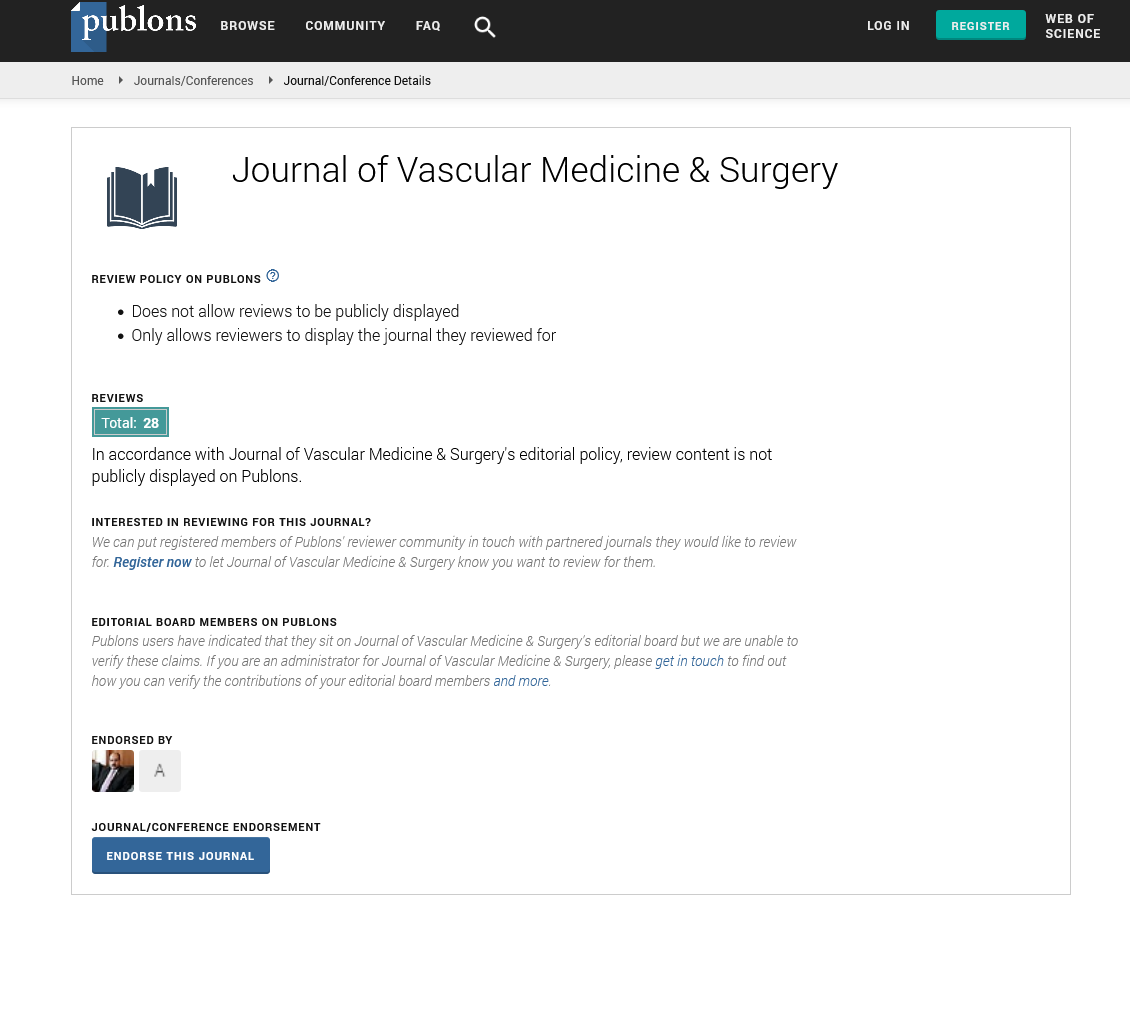Indexed In
- Open J Gate
- Academic Keys
- RefSeek
- Hamdard University
- EBSCO A-Z
- OCLC- WorldCat
- Publons
- Euro Pub
- Google Scholar
- SHERPA ROMEO
Useful Links
Share This Page
Journal Flyer

Open Access Journals
- Agri and Aquaculture
- Biochemistry
- Bioinformatics & Systems Biology
- Business & Management
- Chemistry
- Clinical Sciences
- Engineering
- Food & Nutrition
- General Science
- Genetics & Molecular Biology
- Immunology & Microbiology
- Medical Sciences
- Neuroscience & Psychology
- Nursing & Health Care
- Pharmaceutical Sciences
Perspective - (2025) Volume 13, Issue 4
Vascular Imaging: Beyond Anatomy to Functional Assessment
Dianxiang Lu*Received: 31-Mar-2025, Manuscript No. JVMS-25-28767; Editor assigned: 02-Apr-2025, Pre QC No. JVMS-25-28767 (PQ);; Reviewed: 16-Apr-2025, QC No. JVMS-25-28767; Revised: 23-Apr-2025, Manuscript No. JVMS-25-28767 (R); Published: 30-Apr-2025, DOI: 10.35248/2329-6925.25.13.594
Description
The evolution of vascular imaging has transformed our ability to visualize, characterize, and quantify vascular pathology with unprecedented detail. Beyond simply delineating anatomy, contemporary imaging modalities increasingly provide functional and physiological assessment that directly informs clinical decision-making and therapeutic planning. This transition from purely anatomic to comprehensive functional evaluation represents a fundamental paradigm shift in vascular diagnostics with profound implications for patient management.
Duplex ultrasonography remains the cornerstone of vascular assessment, offering real-time anatomic and hemodynamic evaluation without ionizing radiation or contrast exposure. Technological advances including higher-frequency transducers, enhanced processing algorithms, and microbubble contrast agents have expanded its capabilities and applications. The integration of three-dimensional reconstruction and fusion imaging with CT or MR datasets further extends the utility of ultrasound for complex vascular assessment and interventional guidance. Emerging applications including contrast-enhanced ultrasound for endoleak detection and shear wave elastography for plaque characterization represent promising frontiers for this versatile modality.
Computed Tomographic Angiography (CTA) has likewise progressed beyond simple luminography to sophisticated functional assessment. Dual-energy CT techniques allow material decomposition and virtual non-contrast imaging, reducing radiation exposure while enhancing tissue characterization. Dynamic CTA provides time-resolved imaging that can distinguish arterial from venous phases and identify subtle perfusion abnormalities. Perhaps most significantly, computational fluid dynamics applied to CTA datasets can quantify hemodynamic parameters including wall shear stress, pressure gradients, and flow patterns that influence disease progression and intervention outcomes. These functional metrics have particular relevance for cerebrovascular disease, where fractional flow reserve derived from CT (FFR-CT) can identify hemodynamically significant stenoses without invasive pressure measurements.
Magnetic resonance imaging offers unparalleled soft tissue characterization while avoiding ionizing radiation, making it ideal for longitudinal surveillance. Beyond conventional angiography sequences, advanced techniques including 4D flow imaging provide comprehensive hemodynamic assessment of complex flow patterns, turbulence, and wall shear stress. Blackblood sequences enable detailed vessel wall imaging that can distinguish stable from vulnerable plaque based on intraplaque hemorrhage, lipid core, and fibrous cap integrity. Diffusionweighted imaging identifies subclinical embolic events that may influence intervention decisions, particularly for carotid disease. Similarly, perfusion-weighted techniques quantify tissue-level blood flow that may remain compromised despite macrovascular patency.
Positron emission tomography has emerged as a powerful tool for assessing vascular inflammation, with 18F-Fluorodeoxyglucose (FDG) uptake correlating with metabolic activity in vessel walls. This capability has particular relevance for large vessel vasculitis, where PET can identify active inflammation and monitor treatment response with greater sensitivity than conventional inflammatory markers. Novel tracers targeting specific molecular processes including microcalcification (18F-sodium fluoride), macrophage activity (68Ga-DOTATATE), and angiogenesis (18F-RGD peptides) promise further refinement of vascular molecular imaging.
Conclusion
Invasive angiography has similarly evolved beyond luminology through intravascular assessment techniques. Intravascular ultrasound provides detailed cross-sectional imaging of vessel walls and plaque morphology, while optical coherence tomography offers near-histological resolution capable of identifying thin-cap fibroatheromas, plaque erosion, and thrombus formation. Fractional flow reserve measurement has become standard practice for coronary intervention decision- making and is gaining traction for peripheral applications, particularly in renal and mesenteric vascular beds where the hemodynamic significance of moderate stenoses may be uncertain. The integration of these advanced imaging capabilities with computational modeling has enabled patient-specific flow simulation and device planning. Virtual intervention platforms allow preprocedural testing of various stent configurations, fenestration positions, or bypass geometries to optimize hemodynamic outcomes before physical intervention.
Citation: Lu D (2025). Vascular Access: Navigating Complexity in an Aging Dialysis Population. J Vasc Surg. 13:594.
Copyright: © 2025 Lu D. This is an open access article distributed under the terms of the Creative Commons Attribution License, which permits unrestricted use, distribution, and reproduction in any medium, provided the original author and source are credited.

